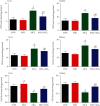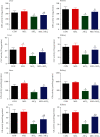The Protective Effects of Melatonin on Aluminum-Induced Hepatotoxicity and Nephrotoxicity in Rats
- PMID: 33133350
- PMCID: PMC7591973
- DOI: 10.1155/2020/7375136
The Protective Effects of Melatonin on Aluminum-Induced Hepatotoxicity and Nephrotoxicity in Rats
Abstract
Aluminum (Al) is a ubiquitous element with known toxicity for both humans and animals. Herein, we aimed to investigate the potential role of melatonin (MEL) in hepatotoxicity and nephrotoxicity following aluminum chloride (AlCl3) treatment in rats. Adult male rats were treated with AlCl3 (34 mg/kg bwt) for eight weeks. Exposure to AlCl3 enhanced the serum activities of the liver transaminases (alanine aminotransferase and aspartate aminotransferase) and increased the level of bilirubin, in addition to the serum kidney function markers urea and creatinine. AlCl3 intoxication boosted oxidative stress, as evidenced by increases in the levels of lipid peroxidation (LPO) and nitric oxide (NO) along with simultaneous decreases in the levels of glutathione (GSH), various antioxidant enzymes, and Nrf2 mRNA expression. MEL (5 mg/kg bwt) treatment repressed LPO and NO levels, whereas it augmented GSH content. The activities of the antioxidant enzymes GPx, SOD, CAT, and GR were also restored concomitantly when MEL was administered before AlCl3. MEL also suppressed the apoptotic effect of AlCl3 by enhancing Bcl-2 protein expression in the liver and kidney and decreasing the expression levels of proinflammatory cytokines. Histopathological findings in the liver and kidney tissues confirmed the beneficial effect of MEL against AlCl3 toxicity. These findings indicate that MEL prevents AlCl3 toxicity by enhancing the antioxidant defense system.
Copyright © 2020 Mohamed S. Othman et al.
Conflict of interest statement
The authors declare that they have no conflicts of interest.
Figures









Similar articles
-
Febuxostat attenuates aluminum chloride-induced hepatorenal injury in rats with the impact of Nrf2, Crat, Car3, and MNK-mediated apoptosis.Environ Sci Pollut Res Int. 2023 Jul;30(35):83356-83375. doi: 10.1007/s11356-023-28182-9. Epub 2023 Jun 20. Environ Sci Pollut Res Int. 2023. PMID: 37340161 Free PMC article.
-
Melatonin reduces oxidative stress induced by ochratoxin A in rat liver and kidney.Comp Biochem Physiol C Toxicol Pharmacol. 2001 Nov;130(3):305-13. doi: 10.1016/s1532-0456(01)00248-4. Comp Biochem Physiol C Toxicol Pharmacol. 2001. PMID: 11701387
-
The protective properties of melatonin against aluminium-induced neuronal injury.Int J Exp Pathol. 2015 Jun;96(3):196-202. doi: 10.1111/iep.12122. Epub 2015 Apr 19. Int J Exp Pathol. 2015. PMID: 25891353 Free PMC article.
-
The roles of melatonin on kidney injury in obese and diabetic conditions.Biofactors. 2020 Jul;46(4):531-549. doi: 10.1002/biof.1637. Epub 2020 May 24. Biofactors. 2020. PMID: 32449276 Review.
-
Aluminum Poisoning with Emphasis on Its Mechanism and Treatment of Intoxication.Emerg Med Int. 2022 Jan 11;2022:1480553. doi: 10.1155/2022/1480553. eCollection 2022. Emerg Med Int. 2022. PMID: 35070453 Free PMC article. Review.
Cited by
-
Biologically Synthesized Gold Nanoparticles Mitigate Aluminum Chloride-Induced Nephrotoxicity via Downregulation of iNOX, LCN2 and IL-1β Genes.Cell Biochem Biophys. 2024 Sep;82(3):2493-2502. doi: 10.1007/s12013-024-01360-3. Epub 2024 Jun 22. Cell Biochem Biophys. 2024. PMID: 38907938
-
Salivary Glands after Prolonged Aluminum Exposure: Proteomic Approach Underlying Biochemical and Morphological Impairments in Rats.Int J Mol Sci. 2022 Feb 18;23(4):2251. doi: 10.3390/ijms23042251. Int J Mol Sci. 2022. PMID: 35216367 Free PMC article.
-
Gallic and Hesperidin Ameliorate Electrolyte Imbalances in AlCl3-Induced Nephrotoxicity in Wistar Rats.Biochem Res Int. 2022 Oct 10;2022:6151684. doi: 10.1155/2022/6151684. eCollection 2022. Biochem Res Int. 2022. PMID: 36263197 Free PMC article.
-
Toxic effects of excess exposure to boric acid on serum biochemical aspect, hematology and histological alterations and ameliorative potential role of melatonin in rats.Saudi J Biol Sci. 2022 Oct;29(10):103425. doi: 10.1016/j.sjbs.2022.103425. Epub 2022 Aug 22. Saudi J Biol Sci. 2022. PMID: 36060109 Free PMC article.
-
A Fundamental Role for Oxidants and Intracellular Calcium Signals in Alzheimer's Pathogenesis-And How a Comprehensive Antioxidant Strategy May Aid Prevention of This Disorder.Int J Mol Sci. 2021 Feb 21;22(4):2140. doi: 10.3390/ijms22042140. Int J Mol Sci. 2021. PMID: 33669995 Free PMC article. Review.
References
-
- Bulan Ö. K., Bayrak B. B., Sarikaya-Ünal G., Yanardağ R. The influence of melatonin supplementation against aluminum-induced toxicity in brains of male rats. Journal of Research in Pharmacy. 2019;23(2):275–283. doi: 10.12991/jrp.2019.134. - DOI
MeSH terms
Substances
LinkOut - more resources
Full Text Sources
Miscellaneous

